Labyrinth of Buda Castle
Intro
From 1983 to 2011, Labyrinth of Buda Castle[1] was the biggest exhibition of the cave- and cellar system of Buda Castle. Since this exhibition collective had been operating for decades, many identified it with the entirety of the Várhegy cavern, wrongly. It got worldwide attention first in 2000, when it was named one of the world's 50 most interesting places - thanks to the Oil Lamp Labyrinth. It was one of Budapest's 10 most liked and most visited cultural targets and a tourism writer named it one of the 7 underground wonders in the world.
History
Cave system: the unique calcareous tuff caves of the Castle Hill were created as an effect of the hot water springs at the dawn of the history of the Earth. These caves then served as refuge as well as hunting ground for the prehistoric man (the “Hunter of Buda”) appearing half a million years ago. For economic and military purposes these originally smaller caves were interconnected and eventually connected to the cellarage of the Castle District's houses. It was used for wine-cellars, torture chambers, jails or treasury during the Middle Ages. The cellars were turned into a shelter and military hospital in the 1930s. At that time the whole cave system could accommodate about ten thousand people at a time. Reinforced – and also disfigured – with concrete, it served as a military installation during the Cold War. In the short interceptions of military utilization and especially since the end of the Cold War, there have been initiatives to turn the labyrinth to cultural uses. A cave museum opened then reopened, and in the early 1980s, the first exhibition of wax figures in Hungary was set up here. However, none of these fulfilled the expectations: the time of wax works and of history closed in vitrines was up. The widely known exhibitions and programs of the Labyrinth of Buda Castle of 1984–2011 are no longer available but the cave system is currently open and can be visited.
Cultural programs (1984–2011)
A significant reconstruction work took place in the Labyrinth in 1996–97. During this the Labyrinth was extended to over 4000 square meters and it regained its pre-war look as far as it was possible. From then on the word “labyrinth” determines the cultural and spiritual profile of the Labyrinth of Buda Castle. In the present context “labyrinth” is a web of paths leading to our world, our history, or ourselves, which, given sufficient resolve, can be charted here. Looking back from the middle or from the end, the area visitors cover will appear as an ordered, meaningful fabric of individual lives and historical destinies rather than a bewildering maze.
In 2011, the Labyrinth introduced a night-time program: the Wanderings with The Great Ones of Europe, one-person wanderings in which the visitors only receive a Labyrinth lantern, while the labyrinth thread was represented by the visions and impulses of influential authors from Europe.
The European Pantheon opened in Spring 2011, an exhibition includes found objects from 37 European countries bearing names of gods.[2]
On 29 July 2011 the police and members of the Inspectorate for the Environment stormed the Labyrinth of Buda Castle. Large numbers of Hungarian and foreign tourists were simply forced to leave the system of cellars. Foreign tourists were at a loss to understand the reasons of the raid and many believed there had been an attempted or actual terror attack.
The staff of the Labyrinth were equally shocked. They were ordered to gather their belongings immediately, during which time they were prohibited from going anywhere without surveillance, and the female staff were not even allowed to lock the toilet door.
The headquarters and the offices of the Labyrinth of Buda Castle were force-evacuated with immediate effect, preventing in a premeditated way the Company from doing its business, building its defence in various court proceedings and even from being available.
Various individuals and organisations had since 2002 sought to snatch the rights to the area and, in actions including the recent raid, to nationalise or usurp it in a way that the Company operating the system of cellars should not have to be compensated for the thirty years of technical, intellectual, tourism and marketing investments it has put into the Labyrinth, and worse, to discredit the Company in every possible way. After many illegal acquisition attempts were foiled in court, yet another unwarranted, forceful police action took place in 2008 on the premises of the Labyrinth. All accusations were denied and the brutal and illegal Roaming in the inky maze with oil lamps. From 6 PM in the Buda Castle Labyrinth the electric lights were replaced by the natural light of oil lamps. That time the historical and other labyrinths were not the illustrations of certain events (wax museum) or its symbolic shape (daytime labyrinth) anymore, but the location of the search for identity, the place of self-understanding (in the anthropologic sense) in an adventorous way.
actions condemned in all proceedings and on every level of court, and the Company won the case.
The recent attack differs from the 2008 raid in that this time the interested circles are seeking to establish an irreversible situation (through judicial vacations, depriving the Company of its own offices, etc.). The director of the Middle-Danube-Valley Inspectorate for Environmental Protection lied without batting an eyelid to the cameras, as he did in press releases published in several electronic or printed media. Cited as conclusive evidence, the fact that the Supreme Court rejected the submissions of the Company is simply not true. Most of the director's statements were false or unjustified, merely serving to legitimise the atrocities that provoked a public outcry. Moreover, the Inspectorate never submitted to the appellate body the petition for the suspension of execution.
In 2008 it was the lack of a tourism permission, this time it is the lack of a land use permit and damage to the environment that is being referred to. The fact that we are looking at pretexts for nationalisation is confirmed by the fact that the exhibitions of the Labyrinth of Buda Castle—built over the past 30 years and unchanged since—have been known to the Inspectorate for decades and it has never raised any objection.
Pantheon of Budapest
The exhibition was opened in the Buda Castle Labyrinth in 2010. Here visitors could see shapes of gods that established and laid down European culture, settled into certain objects. These pieces of malformed faced gods appeared in 37 countries in nearly 180 versions, after collecting them for 25 years. These recent imprints of forgotten European gods are non other than casual rattletraps and consume idols.
Tour with Oil lamps
Roaming in the inky maze with oil lamps. From 6 PM in the Buda Castle Labyrinth the electric lights were replaced by the natural light of oil lamps. That time the historical and other labyrinths were not the illustrations of certain events (wax museum) or its symbolic shape (daytime labyrinth) anymore, but the location of the search for identity, the place of self-understanding (in the anthropologic sense) in an adventorous way.
Labyrinth of Love
Local colour of the personal Labyrinth visiting is the so-called Labyrinth of Love, a new passage. This part was originally developed for engaged couples: the fiancée and the fiancé get into the labyrinth in two different ways. They proceed towards two different ways, and after the wandering they meet each other – in a space with special atmosphere. The Labyrinth of Love is not allowed to visit in the daytime.
Wandering with the Great Creatives of Europe
Presuming individuals that stepped on the path of sole overnight search for identity could choose a guide from significant artificers in the European culture (Dante, Heraclitus, Mozart, Attila József, Endre Ady, János Pilinszky, Goethe, Hölderlin etc.). In the inky mazes, where only the Labyrinth Lantern helped the orientation in space, strong visions and ideas of the chosen guide meant the invisible yarn.
After 2011
European Pantheon
The exhibition was opened in the Buda Castle Labyrinth in 2010. Here visitors could see shapes of gods that established and laid down European culture, settled into certain objects. These pieces of malformed faced gods appeared in 37 countries in nearly 180 versions, after collecting them for 25 years. These recent imprints of forgotten European gods are non other than casual rattletraps and consume idols.
Pictures (1984–2011)
-
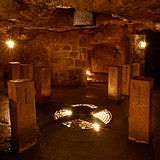
The Axis of the World
-
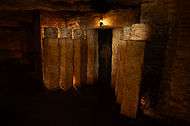
Personal Labyrinth, Entrance to the Inner Circle
-
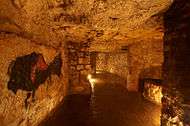
Prehistoric Labyrinth
-
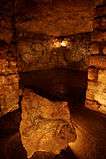
Prehistoric Labyrinth
-
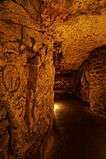
Prehistoric Labyrinth
-
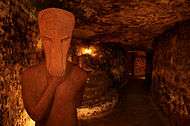
Shaman-passage
-
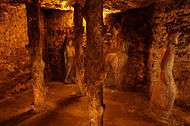
Path of the Magic Deer
-
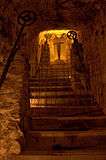
The Hun Elevation
-

Arpadian vaults with the baptismal font
-

The Lost Horseman
-

Tatar corridor
-
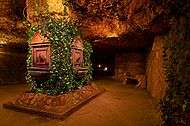
Renaissance Rockhall with the Wine Fountains of Mátyás
-
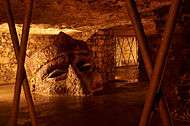
The Crowned Head
-
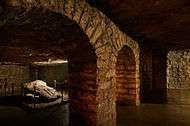
Labyrinth of the end of history
-
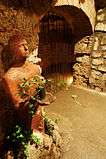
The Ivy Grotto
-
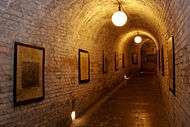
The Labyrinth Exhibition
Coordinates: 47°30′00″N 19°02′03″E / 47.50000°N 19.03417°E
References
http://labirintusbudapest.hu/english.php
- ↑ "Labyrinth of Buda Castle | Welcome". labirintus.com. Retrieved 2015-12-21.
- ↑ European Pantheon